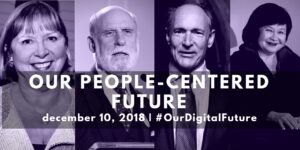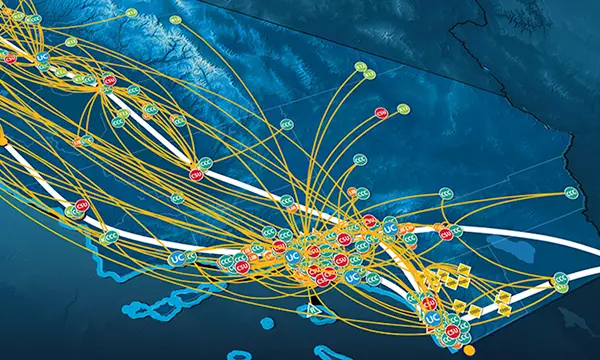- About
- Network
- Community
- Initiatives
- News
- Events
- Blog
- Publications

CENIC Joins Conversation to Plan for Our Digital Future
Categories RENS & NRENS
More than 50% of all people in the world now have internet access. It’s a connectivity milestone that was marked December 10 by the People-Centered Internet’s “Our Digital Future” event, which brought together key internet pioneers and next-generation change agents.
Panel members discussed themes such as digital inclusion and alternative modes of connectivity; community resiliency in the face of natural disasters; and the future of education and work. CENIC’s goals align with these themes as staff work to extend and improve the California Research and Education Network (CalREN) in the service of members and the pivotal work they are doing in science domains such as climate science, medical research, and information technology. CENIC community members were invited to be part of this event.
“It’s important for our community to be involved in this big-picture conversation,” said CENIC President and CEO Louis Fox. “It was a good opportunity for our members in research and education to engage with world internet leaders to discuss new strategies to break down the digital divide and increase access for all.”
The complete event recording is available to watch.
Thinking Differently
People who are not yet online will stand still while the world moves forward. Worldwide, the largest numbers of people who are not yet connected to the internet are in rural China, Africa, and India, though there are significant disparities in access in our own country. “The importance of spreading the internet is not just in its connectivity,” said Vint Cerf, known as a “father of the internet,” having co-designed its architecture. “It’s making it useful for people. Are they healthier? Do they live longer? Do they have more disposable income? Do they feel safer? Can we apply metrics to the presence of the internet so we can demonstrate that its use is positive and beneficial? The People-Centered Internet is all about that.”

The event also marked the 70th anniversary of the Universal Declaration of Human Rights. In 1948 after World War II, the United Nations General Assembly voted to approve the document, which codifies the basic, fundamental rights that all human beings should enjoy and all governments should protect. “If we look at the context of that pre-disaster scenario — discrimination and hate speech, nationalism, demagoguery, disinformation, economic disparity, and exclusion of the lower and middle classes — I imagine this sounds familiar to many of us in this room,” said Scott Campbell, senior human rights officer for the UN’s Office of the High Commissioner for Human Rights. “I think if we add fake news and the internet we’d have 2018.”
In California and nationwide, people living on tribal lands have the lowest internet access rates. “When you hear the incumbent telecommunications companies and communications providers say 98.5% of America is connected, the 1.5% are the tribes,” said Matt Rantanen, director of technology for the Southern California Tribal Chairman’s Association. “Those companies have been spending billions of dollars and they’re not getting connectivity to these regions. It’s time to think differently.” In an interview with CENIC last spring, Rantanen discussed out-of-the-box solutions such as using unlicensed cellular spectrum and TV white space.
Bouncing Forward Better
Community resiliency in the face of natural disasters is the ability for communities to absorb the shock, regroup, and rebuild stronger, according to the Rockefeller Foundation.
“We think in terms of bouncing forward better, rather than bouncing back to a status quo,” said Linton Wells II, executive advisor to the Community Resilience Laboratory at George Mason University. “How do you take advantage of the stress and the shock and make yourself stronger?”
Steven Huter, director for the Network Startup Resource Center and recipient of CENIC’s 2017 Innovations in Networking Award, stressed the importance of natural disaster defense efforts. He highlighted ShakeAlert, seismometers being installed along California and the West Coast for early detection of earthquakes; and ALERTWildfire, cameras being installed in California to detect the first plume of smoke from a wildfire. “I would challenge anybody out there to start looking at how to coordinate a much larger investment in this pro-active approach to detecting tsunamis, earthquakes, and fires,” Huter said. “If we could get these systems built in the coming years, we could save a whole lot of lives.”
Enhancing Career Opportunities
During a discussion on the future of education and work, Alan Lepofsky, vice president and principal analyst for the technology advisory firm Constellation Research, said people need to realize that technology is going to enhance their education and career opportunities rather than take their jobs.
“The future of work related to automation of things is context,” he said. “It’s the number one thing that has to be fixed across everything we do. We should only have access to the right information at the right time. The right people. The right content. The right conversations. Imagine if when you were doing a certain thing, you only saw the things related to that. And that level of automation is going to help us.”
The CalREN network — with its community of universities, community colleges, K-12 schools, libraries, and more — supports innovation that will fuel the future workforce. At universities, scientists conducting research on the Pacific Research Platform and Pacific Wave are able to collaborate on a global scale to make gains in climate science, medical research, and information technology. Design and implementation of the networks serves as a global model for advanced cyberinfrastructure. It is CENIC’s ongoing goal to bring quality, high-speed broadband service to all research and education communities. We at CENIC look forward to forming new relationships and fostering existing ones to establish internet access for all in California.
Many of these issues will be discussed with a detailed focus on California’s efforts at CENIC’s annual conference. Register now to join in these important conversations.
Related blog posts
The Big Game Is Big Data: How CENIC and the California Research and Education Network Support Member Athletics
When Fresno State needed to connect to Pac-12 Enterprises to broadcast a live football game over CBS, the Chancellor's Office reached out to CENIC for what Pac-12 later called the smoothest turn-up they've ever experienced.
Enabling Network-Based Collaboration Around the World: A Tour of CENIC and Partner Network Maps
On the Network Maps page at the CENIC website, you’ll find maps of all the networks, peering facilities, and exchanges to which CalREN connects, showing how thousands of CENIC member institutions connect to CalREN and to colleagues all over the globe.


